The root of the tongue is its base and is located deep in the oropharynx. It complements tongue bodywhich ends with a rounded end. The very root of the tongue is a muscular organ permeated with vessels, nerve endings and lymph nodes, on the state of which all its functionality depends.
Changes in his condition can lead to loss or difficulty speaking, eating disorders and chronic diseases.
Record content:
- 1 Organ characteristic
- 2 Taste buds
- 3 Functions and properties
-
4 Anatomy and structure
- 4.1 Skeletal muscle
- 4.2 Internal muscles of the tongue
-
5 Possible diseases and pathologies
-
5.1 If it hurts
- 5.1.1 Possible reasons
- 5.1.2 Treatment methods
-
5.2 If it smells bad
- 5.2.1 Possible reasons
- 5.2.2 Treatment methods
-
5.3 Yellow-green
- 5.3.1 Possible reasons
- 5.3.2 Treatment methods
-
5.4 Black color
- 5.4.1 Possible reasons
- 5.4.2 Treatment methods
-
5.1 If it hurts
- 6 Language video
Organ characteristic
The root of the tongue is located deep in the mouth, namely in the groove in the lower palate between the teeth. It, like the rest of the tongue, is covered with a mucous membrane. The root of the tongue is its base and consists of several muscles that continue into the body of the tongue. The tongue is considered the strongest muscle in the body and combines 8 different muscles that are woven together and complement each other.
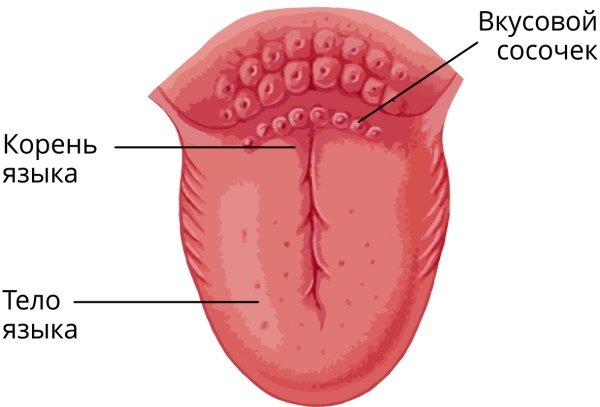
On the outside, the tongue is covered with a mucous membrane, which consists of papillae of various types. It is the presence of papillae that helps to feel the taste and starts the digestion process.
The papillary layer forms a rough surface on the tongue, on which plaque from food or the vital activity of bacteria is quickly deposited. It is the quality and color of the plaque that signals disturbances in the functioning of the body.
Often, according to the state of the tongue, it is possible to establish the presence of diseases of individual organs for further examination and diagnosis, therefore, during the examination, the therapist necessarily notes the color of the tongue.
Taste buds
On the surface of the tongue, in its upper part, from the base of the root to the very end, many papillae and bulbs are scattered, which help to feel the taste in its entirety.
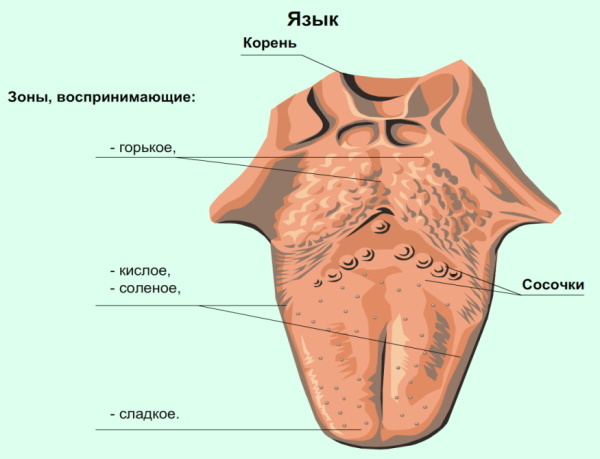
The main types of papillae include:
- mushroom;
- leafy;
- grooved;
- threadlike;
- conical.
But only the first 3 of them help to feel the taste of food and foreign objects. Mushroom papillae are responsible for the definition of sweetness, and leaf-like papillae are responsible for sour taste.
Bulbs also have the ability to taste. It is in them that the glands pass and there are receptors that are able to distinguish between bitter and salty. Certain types of papillae and bulbs are densely located in different parts of the tongue.

Therefore, it is believed that the tip of the tongue quickly determines the sweet, and the root of the bitter. On the sides of the tongue, closer to its root, there are sections that make it possible to identify sour, and closer to the end - salty. The central part of the tongue contains a minimal number of taste receptors and is neutral.
It is important to remember that the tongue is involved in stirring food while eating. The sensation of taste while chewing food causes a feeling of euphoria for individual foods in each person in different ways, depending on his preferences. Different pieces of food, falling on separate parts of the tongue, cause the perception of food in a new way, combining it into a complex combination.
Functions and properties
The root of the tongue is located at the beginning of the pharynx and forms its base. The root of the language performs many functions independently and as a single organ.
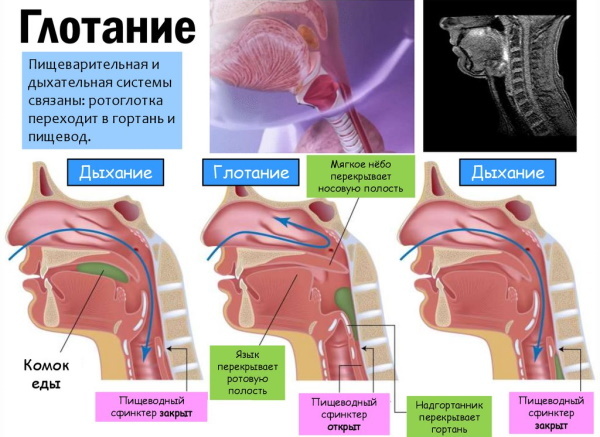
The main functions of the language root include:
- stirring food and pushing it down the throat;
- participation in swallowing, sucking food;
- perception of 5 basic tastes;
- sensitivity to the temperature of food and any items;
- participation in speech by determining the purity of the sound of individual sounds;
- tactile functions for the perception of various foods and objects;
- maintaining the quality of the work of the entire body;
- participation in articulation and expression of feelings.
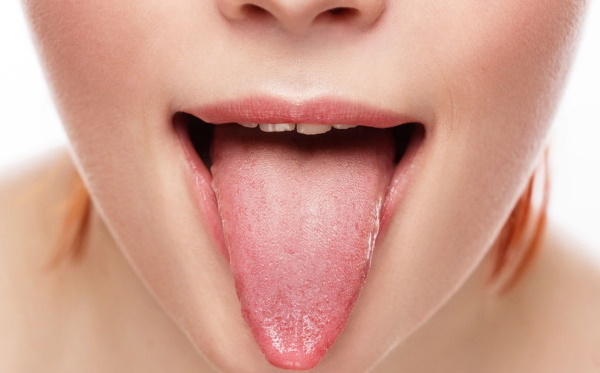
The tongue, when chewing food, starts the process of salivation and determines the beginning of digestion, therefore it is believed that it participates in the process of digestion. A language can perform several functions at the same time and any violation in its work affects the performance of its individual functions.
Anatomy and structure
The tongue consists of 2 main parts: the root and the body of the tongue. The body of the tongue occupies 2/3 of its size and ends with a narrowed round end. The root of the tongue (1/3 of its size) is wider in size and faces the oropharynx. It is attached at the base of the throat section.
The root of the tongue in a calm position lies in the lower palate between the teeth. When moving, its size changes due to muscle stretching.
The main part of the tongue is muscle tissue, which is represented by a group of muscles that is common for the entire tongue. The quality of the muscles of a given organ depends on its mobility and frequency of use. They are divided into 2 main groups depending on their location and attachment.
Skeletal muscle
Skeletal muscle (having a base on the skeletal portion) includes:
- hyoid muscle, which is attached to the base of the hyoid bone. Further, it stretches along the lateral part of the tongue to the very end. This muscle has several basic functions. She not only pulls the tongue down and back, but also has the ability to lower the epiglottis down. This closes the larynx when swallowed;
- styloid muscle, which originates on the chin of the lower jaw. It is located in the lower and lateral regions of the tongue. This muscle helps to lift the tongue and pulls it back;

- chin-lingual muscle is the main accessory muscle of the tongue. It runs from the chin to the end of the vertical part of the tongue. Its main function is to pull it forward;
- lingual muscle considered internal and located inside the sublingual part. This muscle lifts the root of the tongue and complements the rest of the muscles.
Internal muscles of the tongue
Internal muscles of the tongue that are not attached to the skeletal portion include:
- lower longitudinal;
- transverse;
- upper longitudinal;
- vertical.
The internal muscles are located in the tongue according to their name. These muscles, complementing each other, are able to change the shape of the tongue and largely determine its movements. This muscle group only works in conjunction with other muscles.

The outer side of the tongue root is covered by intermuscular connective tissue and mucous membrane. There is no submucosal layer in the tongue, therefore the mucous membrane (stratified epithelium) does not fold on the surface, but lies firmly on the base. At the end of the root of the tongue from the upper side on the surface of the tongue there are roughness and small papillae.
On the root and body of the tongue, 5 main types of papillae can be found:
- threadlike, which have the ability to touch and help keep food on the tongue;
- mushroom, which are responsible for taste sensations and recognize sweet;
- conical feel pain, food temperature and have tactile functions;
- grooved, which especially densely fill the upper part of the tongue. They are also responsible for the perception of taste;
- leafy are responsible for the sensation of sour taste.
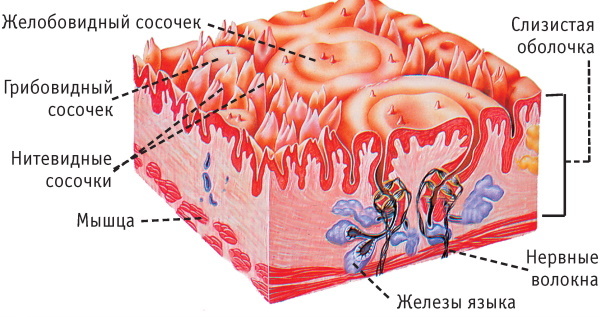
At the root of the tongue, in the upper part of it, there are also taste buds. They have a system for analyzing taste and help to sense all possible variants of sensations. Several glands are located at the root of the tongue. They originate at the root of the tongue and are located along its entire length.
There are several types of glands:
- mucous membranes located in the papillary layer;
- serous, running in the lateral parts and partially inside the tongue;
- mixed.
The posterior glands are concentrated at the root of the tongue. These are numerous glands of different types, which are located and permeate the muscle fibers of the organ. With small ducts, the posterior glands go into the grooves and small papillae of the back of the tongue, creating a dense part of the organ.
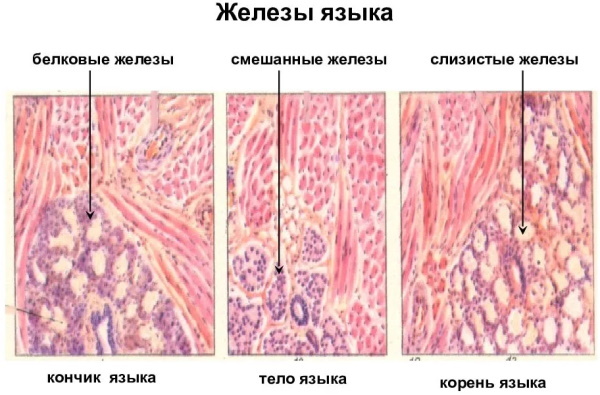
Beyond the posterior groove at the root of the tongue is a node of lymphoid tissue, which forms follicles of different sizes. This lymphoid compound is called the lingual tonsil. It is in this place that the mucous membrane of the tongue has an elevation with a fossa in the center (script). The lingual tonsil forms part of the lymphatic system of the epithelium in the pharynx.
Lymphatic fluid enters through the nodes of the lymphatic system, which are located under the jaw and chin, as well as in the pharynx.
The supply of the tongue with nutrients and oxygen is carried out through the large vascular branches of the organ, which permeate the entire body. And venous outflow occurs through the jugular vein. All vessels in the tongue are large enough and often penetrate its main body.
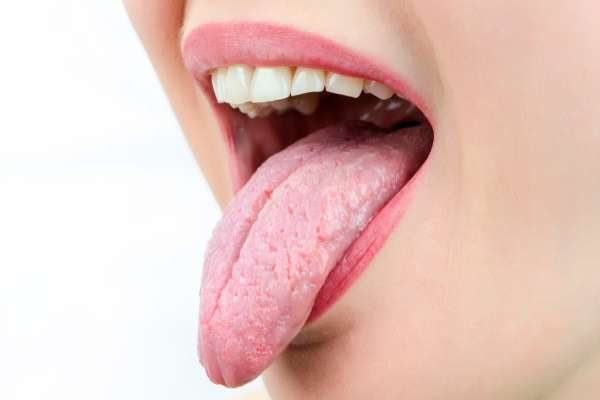
The nervous system of the tongue is represented by a network of nerve endings that permeate the entire body of the organ. It is they who provide its increased mobility.
Possible diseases and pathologies
The root of the tongue is located partially in the oropharynx and therefore it is rather difficult to establish all possible diseases and pathologies of this part of the organ. Most often, patients turn to a specialist at the acute stage of the manifestation of the disease, when painful sensations appear in the tongue.
Sometimes the main symptom of the disease is bad breath or plaque on the tongue, which is constantly present. With such symptoms, only a specialist can accurately establish a diagnosis, subject to the necessary examination.
If it hurts
Pain at the root of the tongue appears mainly during movement and can be expressed by severe pain syndrome or minor discomfort, which interferes with the performance of the basic functions of the tongue.
Possible reasons
In most cases, the root of the tongue hurts for the following reasons:
- injury that occurs as a result of cuts, injections, or damage to the root of the tongue by foreign objects. Tongue injuries can be associated with ingestion, foreign objects getting stuck, or as a consequence of surgery. Minor tongue injuries heal quickly without additional treatment, while large and deep injuries require systemic treatment;
- viral infections, as a result of which the virus enters the tongue through the blood, causing pain and ulcerative rashes on its surface. This process usually affects not only the tongue, but also the tonsils and pharynx;
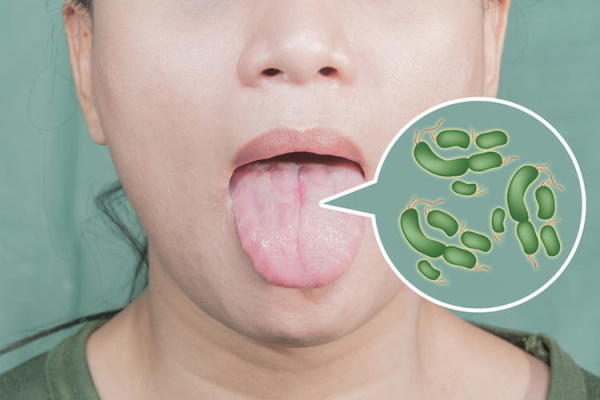
- the development of a goiter affects the enlargement of the thyroid gland, the share of which is located at the root of the tongue.
Treatment methods
To restore the functionality of the language, the following treatment methods are used:
- dietary food during the treatment period with a large amount of liquid food and a decrease in the portion size;
- treatment of the surface of the tongue with antiseptic compounds (chlorhexidine, hydrogen peroxide, brilliant green);
- drug therapy, which includes antibiotics that have an effect on a wide range of pathogenic bacteria and viruses (ceftriaxone, ampicillin). Antibiotics allow you to remove a viral infection and restore the condition of the tongue;
- surgical intervention is carried out with a volumetric injury to the root of the tongue and the development of a goiter. From the site of injury, foreign bodies and growths are excised, and the site of damage is restored while maintaining the muscles and mobility of the tongue;
- rinsing with decoctions of herbs with an antiseptic effect (chamomile, sage) is used as folk methods for treating viral infections and injuries of the tongue.
If it smells bad
The root of the tongue has a complex attachment and is located at the base of the throat, therefore it can be quite difficult to determine exactly where the unpleasant smell comes from.

Self-treatment in this case can lead to a deterioration in health and at the initial stage it is recommended to consult a specialist for advice.
Possible reasons
The most common causes of bad breath can be:
- diseases of the stomach (ulcer or gastritis), when the multiplication of bacteria in the stomach as a result of a violation of its integrity leads to the release of bad breath. A person can sense that the smell comes from the root of the tongue;
- insufficient oral hygiene;
- carious processes in the teeth.
Treatment methods
If you have bad breath, you need to:
- establish a rigid oral hygiene schedule. Thoroughly brush your teeth 2 times a day and rinse them with special balms;
- revise the diet, removing almost completely the use of spices, onions and garlic. Reduce the intake of fatty, salty foods to a minimum;

- to treat dental caries;
- as prescribed by a doctor, undergo a course of treatment of the stomach when it is established as a result of examination of violations in the work of the digestive system, which includes taking medications to reduce the acidity of gastric juice and restore the gastric mucosa (de-nol, almagel).
Yellow-green
The root of the tongue, like its body, almost always has a slight coating. Sometimes its color can become more saturated and have a yellow or yellowish-green tint. In this case, plaque can signal pathologies in the work of the whole organism, which require careful examination.
Possible reasons
A yellow-green coating on the tongue can result from:
- the use of specific food or certain medications;
- violations in the liver;
- stomach diseases;
- kidney disease;

- vitamin deficiency;
- viral diseases (influenza, ODS);
- fungal infections;
- HIV infection.
Treatment methods
In the case of the constant presence of a yellow-green plaque and the appearance of concomitant symptoms, the following measures are taken for treatment:
- course treatment of the kidneys (furadonin, kanefron);
- treatment of the liver with drugs (oatsol, cholemzin), which restore the liver from the inside and promote the secretion of bile in greater quantities;
- taking drugs to restore the work of the stomach (fasfalugel, omez, mezim), enveloping the surface of the stomach and promoting its healing;
- treatment with antifungal drugs (chlorophyllipt, fluconazole), which suppress the growth of fungal infections;
- irrigation of the throat with antiseptic drugs (miramistin, chlorhexidine) to flush out the waste products of bacteria;
- folk remedies for treating plaque in the throat include rinsing the oropharynx with a decoction of cultural peony, the leaves of which are brewed with boiling water at the rate of 1 tsp. l. leaves for 1 tbsp.;
- taking a course of vitamins (alphabet, complevit, suprastin).
Black color
The root of the tongue is in constant contact with the mouth and throat, making it difficult to pinpoint the source of any plaque. At the root of the tongue, black plaque may be present, which can settle not only on the tongue, but also on the teeth and mucous membranes. This plaque can be permanent, painful or not.
Possible reasons
In most cases, black deposits appear as a result of:
- a sharp change in the diet with increased consumption of fatty foods, carbohydrates. In this case, the acid base balance in the body shifts towards greater oxidation. As a result, a black coating may appear on the surface of the tongue;
- poisoning of the body with toxins of chemical origin;
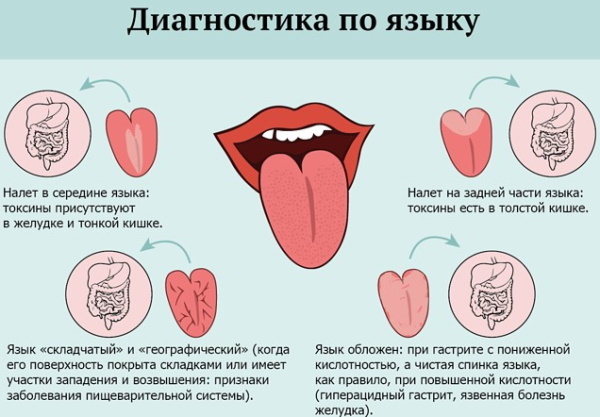
- the appearance of intestinal and liver diseases;
- fungal diseases of the oral cavity;
- systematic use of alcoholic beverages.
Treatment methods
If a dark plaque appears on the surface of the tongue, it is important to undergo an examination in order to accurately determine the cause of this manifestation.
Often, to correct the external state of the language, it is enough:
- change your diet and stick to dietary foods;
- exclude the intake of alcoholic beverages;
- take absorbent drugs (polysorb, enterosgel), which help to "neutralize" and remove all toxins from the body;

- to carry out therapy for the treatment of diseases of the liver and intestines, taking into account the diagnosis;
- take a course of antifungal drugs (deflucan, flucostat) to restore the microflora of the oral cavity.
The root of the language has a unique structure that allows it to perform many functions. His condition is directly related to the volume of movements performed by him.
Continuous monitoring of oral hygiene and monitoring of the condition of the tongue allows you to quickly identify the disease that has appeared. And timely competent treatment with modern drugs can reduce painful sensations and restore the mobility of the tongue within 2-3 days.
Language video
Anatomy of the tongue:



